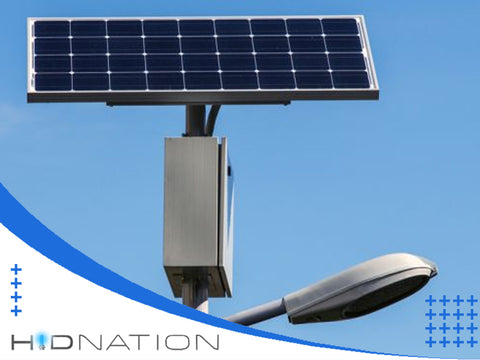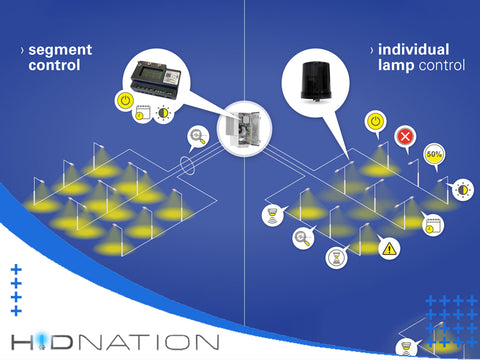In this article, we’re going to take a look at how street light bulbs work. We’ll talk about how they are made, how they are powered, and how they are controlled.
In addition, we’ll also talk about some of the problems homeowners have with their street lights. We’ll also give some tips on how to solve them.
How Do Street Light Bulbs Work?
Street light bulbs are an important part of the lighting infrastructure for our cities. They provide the illumination needed for safe driving at night and protect our environment by reducing energy waste and carbon emissions.
Many people wonder how streetlights work; the answer is that they are powered by photovoltaic cells. These cells create electricity when sunlight hits them and can be controlled to turn the lights on and off, depending on how much sunlight is available at that time.

The lights use a light sensor that detects the amount of daylight at any given moment and tells the computer within the lamp to switch it on and off, depending on whether it is dark or light enough at that time. This ensures that the street lights are only on when needed, preventing a significant amount of unnecessary energy consumption.
Some light fixtures even have a photocell, a light-sensitive sensor that detects when it is too dark to allow the flow of electricity through the LED. These sensors have time delays and hysteresis to prevent the street light from changing states too quickly, which can cause safety issues for drivers.
High-Pressure Sodium (HPS) Lamp
Another type of light fixture is the High-Pressure Sodium (HPS) lamp, which uses sodium vapor to produce light. They are a common choice because they require little maintenance and are relatively efficient at producing light. However, they are slow to turn on and emit a yellow-orange glow that interferes with astronomers’ ability to make measurements of distant stars.
Other lights include optically efficient lighting equipment, which directs a certain percentage of the light from the bulb onto the road's surface in a desired pattern. This helps to reduce light pollution and glare in the street.
In addition, these lights do not contain phosphors, which can cause blinding glare and heat buildup, and they do not emit ultraviolet light that attracts bugs. They are also very energy efficient, making them an excellent choice for homes and businesses that want to save on utility bills.
How Are They Powered?
The way street light bulbs are powered has changed a lot since the days of the arc lamp.
Today, the most commonly used street lights are high-pressure sodium (HPS) lamps. These lamps can draw up to 1000 watts of power. They also produce a brighter light than the incandescent lamps they replaced.

Some of the latest models are powered by LEDs, which are a more efficient form of electricity and can save on energy costs over time. In many parts of the world, this technology is being used to replace traditional bulbs and save on power bills.
Historically, lights were powered by connecting each bulb in series. This allowed the current to travel longer distances without experiencing excessive line loss.
Early series circuits were aided by isolation transformers or film cutout technology. These devices carried the voltage across the circuit even if a bulb burned out.
This is especially important in the case of HPS lamps, as they can be extremely hot. Similarly, fluorescent and metal halide lights are also powered by bypass technology.
Bypass technology
Bypass technology is used in conjunction with isolated transformers to create a circuit that can carry the electricity from each bulb. This is done to avoid having the entire system go dark if one bulb burns out.
Isolated transformers
Isolated transformers can also be a good way to ensure the quality of a lamp. This is because they can isolate the electricity and not allow it to damage other components, ensuring that only working bulbs will operate.
Bypass technology has come a long way. Now it is much easier to install, maintain, and repair than it was in the past. This is because isolation transformers can now be manufactured from solid plastic or aluminum. So, they are lighter and more durable than their predecessors.
How Are They Controlled?
Streetlights have a variety of controls. They are usually operated by a clock that switches them on at night and off during the day. They also have photocells that measure the ambient light level and switch them on or off.

Self-Adapting-Midnight
One type of system uses a combination of photocell switches and timing dimming, allowing for the street lights to dim as it gets dark. This is known as Self Adapting Midnight. It can be set to happen at sunset or when the sun rises again in the morning.
Some systems use pulse width modulation to control the brightness of the LED headlight bulbs. This technique allows the lights to be dimmed without affecting the quality of light they provide. These methods generally save up to 50% of the energy used by traditional LEDs.
A smartphone app can also control these systems. Some even have a built-in GPS sensor to let the lights dim or switch off when not in use. It will save a city up to 40% of its electricity costs.
This technology is also used in other sectors. Such as car parks and retail stores. It can help make shops more appealing to shoppers by dimming the lights to reflect daylight during the day and illuminating them at night. It can also protect the environment by detecting and dimming lights when there is heavy rainfall or snow, reducing pollution.
Conclusion
There are many different types of streetlights. And they range from primary light-emitting diodes (LEDs) to advanced smart LED streetlighting systems with sensors and camera technology. Some of these systems can be remotely managed. It can automatically dim or turn off when little activity surrounds the area and reduce energy usage.
Read Also: What Do You Know About the Historical Evolution of Street Lighting - Modern Era?
FAQs
How Does a Street Light System Work?
In today's smart cities, connected lighting systems make streets safer and more vibrant. In addition, they help control traffic and manage parking spaces.
Intelligent street lights adjust the brightness based on footfall and occupancy and dim when sensors detect fewer people or cars in the area. They also adapt to seasons and weather, reducing energy usage in changing situations.
How Are the Bulbs of Street Lights Connected?
Street light bulbs are usually fed from a mains electricity cable. This could be from your local authority supply or a DNO (Distribution Network Operator) supply.
The bulbs are connected in parallel, meaning that if one bulb fails, the other will continue to glow.
What is the Methodology of a Smart Street Light System?
The key objective of a smart street light is to reduce energy consumption, CO2 emission, and maintenance costs.
A key component of a smart street light is the flux regulation system. It allows the lighting to be adjusted following traffic and environmental conditions. This is achieved by utilizing sensors and communication networks.
What Are the Components of a Street Light?
A street light is a system of poles illuminating streets, sidewalks, and roadways. They are usually made of corrosion-resistant metal or plastic to withstand the outdoors.
Solar panels, batteries, or main power can power streetlights. They are designed to work automatically from dusk to dawn.



